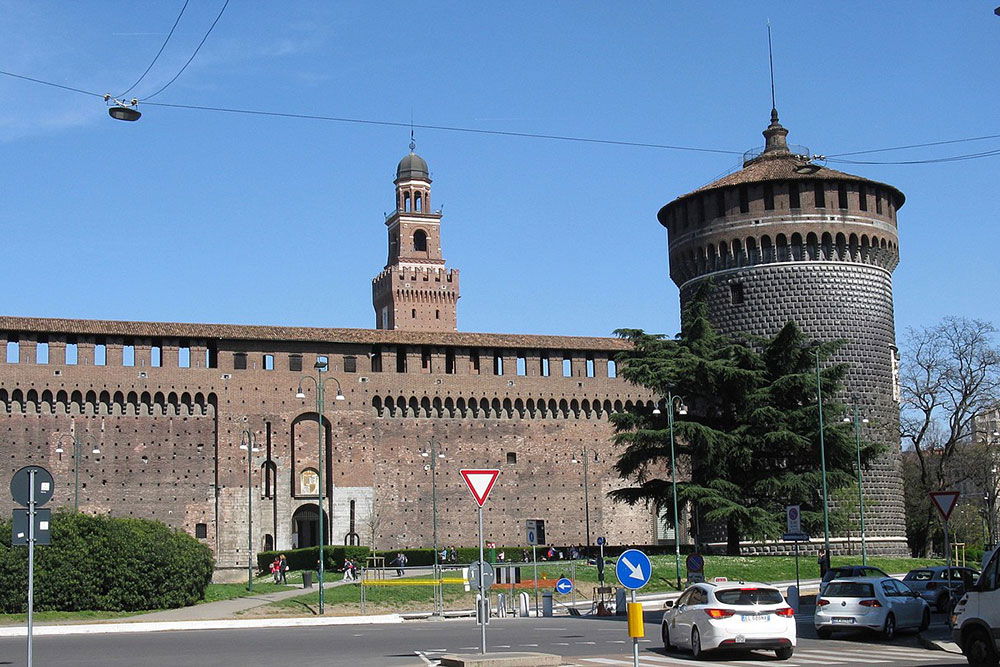
Milan, Italy’s fashion capital and cosmopolitan hub, holds within its heart a timeless symbol of power, resilience, and artistic heritage: the Sforzesco Castle (Castello Sforzesco). More than just a historic fortress, this immense red-brick structure stands as a grand repository of Milan’s turbulent past and its glittering cultural riches.
Constructed in the 15th century and continually restored through the centuries, Sforzesco Castle today is a sprawling complex of museums, courtyards, towers, and artistic treasures. It offers visitors a fascinating journey through time, from the Middle Ages to the Renaissance and beyond.
The origins of the Sforzesco Castle date back to the 14th century, when the Visconti family, rulers of Milan, built a fortress on the site. However, the castle as we know it took shape under Francesco Sforza, a powerful condottiero (mercenary leader) who married into the Visconti family and later became Duke of Milan in 1450. Wanting to establish his dominance and elevate his dynasty, Sforza transformed the ruins of the old fortress into a majestic palace and stronghold.
The new castle symbolized both military might and refined courtly culture, designed by leading architects of the time, including Filarete, who designed the main tower, and later enriched by artists such as Leonardo da Vinci.
During the reign of Ludovico Sforza, also known as "Il Moro," the castle reached its artistic zenith. Ludovico invited Leonardo da Vinci to Milan, commissioning him to decorate several rooms in the castle. One of Leonardo’s contributions is the stunning ceiling of the Sala delle Asse, where he painted an intricate tangle of tree branches and golden ropes, a vivid display of Renaissance creativity and symbolism.
Though many of Leonardo’s works in the castle were lost or damaged over time, ongoing restoration efforts have revealed more of his genius, making the castle a point of pilgrimage for art and history lovers.
Over the centuries, the castle was battered by foreign invasions and political upheavals. During Spanish and Austrian rule, the Sforzesco Castle was repurposed as military barracks. Napoleon Bonaparte even ordered parts of it to be demolished.
By the 19th century, the castle had fallen into disrepair, but a growing movement to preserve Italy’s historical landmarks led to its extensive restoration in the late 1800s, under architect Luca Beltrami. Thanks to his vision, the castle regained its former splendor, and the Filarete Tower, which had collapsed, was rebuilt in 1905.
Today, Sforzesco Castle is not just a monument, it's a cultural epicenter. It houses several museums and art collections, including:
The Museum of Ancient Art, featuring sculptures, armor, and tapestries, including the impressive tomb of Gaston de Foix.
The Pinacoteca (Art Gallery), home to masterpieces by Titian, Mantegna, and Canaletto.
The Egyptian Museum, with artifacts from ancient Egypt.
The Museum of Musical Instruments, one of the most important in Europe.
The Pietà Rondanini Museum, showcasing Michelangelo’s last, unfinished sculpture, a profoundly moving and fragile piece.
Each museum invites visitors to delve into different aspects of Italian and world history, making the castle a destination worthy of multiple visits.
The castle’s vast central courtyard, grand gates, and multiple towers make it an architectural wonder. The Cortile della Rocchetta and Corte Ducale are peaceful spots surrounded by red-brick walls and arcades, reflecting a mix of Gothic and Renaissance styles.
Surrounding the castle is the expansive Parco Sempione, one of Milan’s largest green spaces. Designed in the English landscape garden style, the park is ideal for a stroll after visiting the castle. It also offers views of the Arco della Pace (Arch of Peace), adding another layer of historical depth to the area.
The castle is more than a static monument, it’s a vibrant venue for cultural events, temporary exhibitions, concerts, and historical reenactments. Whether you're exploring its vast halls or attending a nighttime event in the courtyard, the castle offers a truly immersive experience.
Location: Piazza Castello, Milan. Just a short walk from the Duomo and accessible by Metro (Cairoli or Cadorna stations).
Opening Hours: Usually open from Tuesday to Sunday, 9:00 am to 5:30 pm. Museums may have different hours.
Entrance Fee: Entry to the castle grounds is free. Museum tickets are reasonably priced and often include multiple exhibitions.
Guided Tours: Available in multiple languages, offering rich context and stories behind the artworks and architecture.
Visiting Sforzesco Castle offers more than just a glimpse into Milan’s past, it’s an encounter with the legacy of the Renaissance, the rise and fall of dynasties, and the enduring power of art and culture. Whether you’re an art lover, a history enthusiast, or simply curious about the soul of Milan, the castle is a must-see destination.

More Details